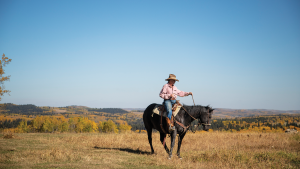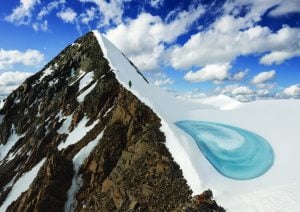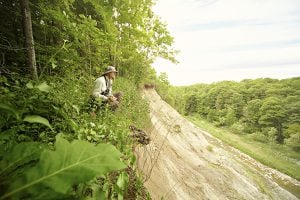What makes this spot hot?
- One of the few places in Alberta where you can drive to an alpine meadow.
- Cadomin Cave provides important habitat for bats; it’s one of only four spots in Alberta where bats can overwinter.
- Over 277 plant species including many that are rare.
If you love truly wild places, head for Whitehorse Wildland Provincial Park located about an hour’s drive south of Hinton. The park shares its western border with Jasper National Park. On the drive up to the park, especially if you go to the divide, you’ll feel like you’re heading off on a remote adventure.
Visitors can explore the park via a backcountry trail that begins at the Whitehorse Creek Provincial Recreation Area, not far from Cadomin or on foot from the Cardinal Divide Viewpoint Parking Lot. The trail to the Cadomin Bat Caves (Alberta’s largest bat hibernation cave) is temporarily closed to reduce the risk of white-nose syndrome, a fungal disease that kills cave roosting bats.
The Cardinal Divide
If you head for the Cardinal Divide, a high clearance vehicle is recommended in case there are issues with the road. The drive up the dirt road passes an active coal mine with massive trucks at work on their own dedicated road. Once you get past the mine, you’ll be struck by the beauty of the wilderness, prime habitat for a variety of animals including elk, moose, mule deer, bighorn sheep, black bears, wolves, cougars, marmots and pika. The Cardinal Divide sits at an elevation of 1,981 metres on the division of two major river systems. The McLeod River drains into the Athabasca River, which flows north to empty into the Arctic Ocean. To the south, the Cardinal River flows into the Brazeau River and then into the North Saskatchewan River, which flows east across the prairies to drain into Hudson Bay.
The area around Cardinal Divide can only be explored on foot and camping is not permitted. Extensive alpine meadows, renowned for their summer wildflowers and sub-alpine slopes will beckon the hiker. Stay on the unmarked trails to protect the very fragile soil and plants. Some people attempt to scramble up the closest mountain you can reach on foot. Another hiking option is to follow the dirt track from the parking lot east up the ridge for gorgeous views of the upper foothills.
Whitehorse Creek Staging Area
It’s also possible to hike, backpack or horseback ride into the park from the Whitehorse Creek Provincial Recreation Area. To find it, look for a turnoff marked “camping” on the road up to the Cardinal Divide not far from Cadomin. There are a number of campsites by the trailhead that can also accommodate horses.
The Lower Whitehorse Trail takes you through prime grizzly country so be bear aware. You can actually do several multi-day trips; one over Fiddle Pass and into Jasper National Park or visit the Wildhorse Creek Falls. There are several backcountry campsites along the trail. As you hike or ride look for some of the 277 different plant species that live in the park, including 37 that are rare. One, a moss, Bryum porsildii, is found only at a few other locations in the world. At the lower elevations you may also spot harlequin ducks and some of the 128 bird species that visit the park.
Dry Island Buffalo Jump










